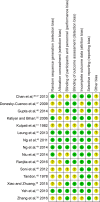Effectiveness of meditative movement on COPD: a systematic review and meta-analysis
- PMID: 29713157
- PMCID: PMC5909800
- DOI: 10.2147/COPD.S159042
Effectiveness of meditative movement on COPD: a systematic review and meta-analysis
Abstract
Background: The effectiveness of meditative movement (tai chi, yoga, and qigong) on COPD remained unclear. We undertook a systematic review and meta-analysis to determine the effectiveness of meditative movement on COPD patients.
Methods: We searched PubMed, Web of Science, EMBASE, and the Cochrane Center Register of Controlled Trials for relevant studies. The methods of standard meta-analysis were utilized for identifying relevant researches (until August 2017), quality appraisal, and synthesis. The primary outcomes were the 6-minute walking distance (6MWD), lung function, and dyspnea levels.
Results: Sixteen studies involving 1,176 COPD patients were included. When comparing with the control group, the 6MWD was significantly enhanced in the treatment group (3 months: mean difference [MD]=25.40 m, 95% CI: 16.25 to 34.54; 6 months: MD=35.75 m, 95% CI: 22.23 to 49.27), as well as functions on forced expiratory volume in 1 s (FEV1) (3 months: MD=0.1L, 95% CI: 0.02 to 0.18; 6 months: MD=0.18L, 95% CI: 0.1 to 0.26), and FEV1 % predicted (3 months: 4L, 95% CI: 2.7 to 5.31; 6 months: MD=4.8L, 95% CI: 2.56 to 7.07). Quality of life for the group doing meditative movement was better than the control group based on the Chronic Respiratory Disease Questionnaire dyspnea score (MD=0.9 units, 95% CI: 0.51 to 1.29) and fatigue score (MD=0.75 units, 95% CI: 0.42 to 1.09) and the total score (MD=1.92 units, 95% CI: 0.54 to 3.31).
Conclusion: Meditative movement may have the potential to enhance lung function and physical activity in COPD patients. More large-scale, well-designed, multicenter, randomized controlled trials should be launched to evaluate the long-range effects of meditative movement.
Keywords: COPD; meditative movement; meta-analysis; qigong; tai chi; yoga.
Conflict of interest statement
Disclosure The authors report no conflicts of interest in this work.
Figures







Similar articles
-
Effects of Tai Chi on exercise capacity and health-related quality of life in patients with chronic obstructive pulmonary disease: a systematic review and meta-analysis.Int J Chron Obstruct Pulmon Dis. 2014 Nov 7;9:1253-63. doi: 10.2147/COPD.S70862. eCollection 2014. Int J Chron Obstruct Pulmon Dis. 2014. PMID: 25404855 Free PMC article.
-
Neuromuscular electrostimulation for adults with chronic obstructive pulmonary disease.Cochrane Database Syst Rev. 2018 May 29;5(5):CD010821. doi: 10.1002/14651858.CD010821.pub2. Cochrane Database Syst Rev. 2018. PMID: 29845600 Free PMC article.
-
Integrated disease management interventions for patients with chronic obstructive pulmonary disease.Cochrane Database Syst Rev. 2021 Sep 8;9(9):CD009437. doi: 10.1002/14651858.CD009437.pub3. Cochrane Database Syst Rev. 2021. PMID: 34495549 Free PMC article.
-
Self-management interventions for people with chronic obstructive pulmonary disease.Cochrane Database Syst Rev. 2022 Jan 10;1(1):CD002990. doi: 10.1002/14651858.CD002990.pub4. Cochrane Database Syst Rev. 2022. PMID: 35001366 Free PMC article.
-
Tai Chi for improving cardiopulmonary function and quality of life in patients with chronic obstructive pulmonary disease: a systematic review and meta-analysis.Clin Rehabil. 2016 Aug;30(8):750-64. doi: 10.1177/0269215515604903. Epub 2015 Sep 22. Clin Rehabil. 2016. PMID: 26396162
Cited by
-
The impact of traditional mind-body exercises on pulmonary function, exercise capacity, and quality of life in patients with chronic obstructive pulmonary disease: a systematic review and meta-analysis of randomized controlled trials.Front Med (Lausanne). 2024 Jun 19;11:1359347. doi: 10.3389/fmed.2024.1359347. eCollection 2024. Front Med (Lausanne). 2024. PMID: 38966524 Free PMC article.
-
Utilization of Mind-Body Intervention for Integrative Health Care of COVID-19 Patients and Survivors.Int J Environ Res Public Health. 2022 May 29;19(11):6618. doi: 10.3390/ijerph19116618. Int J Environ Res Public Health. 2022. PMID: 35682203 Free PMC article. Review.
-
The effect of meditative movement for glucose control in patients with type 2 diabetes: A protocol for systematic review and meta-analysis of controlled trails.Medicine (Baltimore). 2019 May;98(19):e15639. doi: 10.1097/MD.0000000000015639. Medicine (Baltimore). 2019. PMID: 31083263 Free PMC article.
-
Neuroimmune recognition and regulation in the respiratory system.Eur Respir Rev. 2024 Jun 26;33(172):240008. doi: 10.1183/16000617.0008-2024. Print 2024 Apr. Eur Respir Rev. 2024. PMID: 38925790 Free PMC article. Review.
-
Mind-Body Exercise (Wuqinxi) for Patients with Chronic Obstructive Pulmonary Disease: A Systematic Review and Meta-Analysis of Randomized Controlled Trials.Int J Environ Res Public Health. 2018 Dec 28;16(1):72. doi: 10.3390/ijerph16010072. Int J Environ Res Public Health. 2018. PMID: 30597878 Free PMC article.
References
-
- World Health Organization World Health Statistics. [Accessed November 24, 2009]. Online document at: Available from: http://www.who.int/gho/publications/world_health_statistics/en/
-
- Zhong N, Wang C, Yao W, et al. Prevalence of chronic obstructive pulmonary disease in China: a large, population-based survey. Am J Respir Crit Care Med. 2007;176(8):753–760. - PubMed
-
- Vestbo J, Hurd SS, Agustí AG, et al. Global strategy for the diagnosis, management, and prevention of chronic obstructive pulmonary disease: GOLD executive summary. Am J Respir Crit Care Med. 2013;187(4):347–365. - PubMed
-
- Seemungal TA, Donaldson GC, Paul EA, Bestall JC, Jeffries DJ, Wedzicha JA. Effect of exacerbation on quality of life in patients with chronic obstructive pulmonary disease. Am J Respir Crit Care Med. 1998;157(5 Pt 1):1418–1422. - PubMed
-
- Divo M, Pinto-Plata V. Role of exercise in testing and in therapy of COPD. Med Clin North Am. 2012;96(4):753–766. - PubMed
Publication types
MeSH terms
LinkOut - more resources
Full Text Sources
Other Literature Sources
Medical

